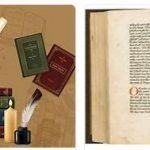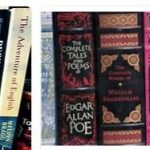
Persian literature, the literature written in the neo-Persian language.
Important works of Persian literature (selection)
- Firdausi: »Book of Kings« (around 1010, national epic)
- Sanai: “Garden of True Reality” (around 1130, didactic epic)
- Nisami: »Chamse« (approx. 1176–97, epic collection)
- Attar: “Bird Talks” (1187, mystical epic)
- Omar-e Chajjam: »Rubajjat« (11th / 12th century, quatrain)
- Saadi: »Obstgarten« (1257, poem), »Rosengarten« (1258, prose with verse)
- Djalal od-Din Rumi: »Masnawi« (around 1263, didactic epic)
- Ubaid-e Sakani: “The Ethics of the Nobles” (1340, Satrian prose)
- Hafis: »Diwan« (around 1368, Ghaselen)
- S. M. A. Djamalsade: “Once upon a time” (1921, short stories)
- Nima Yuschidsch: »Afsane« (1921, poem)
- S. Hedajat: “The blind owl” (1936, novel)
- Ahmad Schamlu: “Fresh Air” (1957, poems)
- F. Farrochsad: »Rebirth« (1964, poems)
According to Programingplease, forerunners of Persian literature were the ancient Iranian sacred texts (Avesta) and the ancient Persian literature of the Achaemenids from the 6th to 4th centuries. Century BC BC, which is only found in inscriptions on rock faces (e.g. Bisutun), buildings, tablets, vessels and others. is preserved; it is partly historical and chronic, partly formulaic.
Middle Persian literature (Middle Persian language and literature) preceded the New Persian one and had a direct impact on it, especially in the epic (especially the “Shah name”) and moral and ethical genres.
After the conquest of Iran by the Muslim Arabs (middle of the 7th century), the Middle Persian language was supplanted from courtly and religious life by Arabic, but remained the language of the Zoroastrian writings and continued to develop orally. The Persian language, which emerged in the following centuries, adopted the Arabic script and integrated Arabic lexicons. Persian was promoted as a literary language at the royal courts of Khorasan (north-east Iran) and Transoxania from the 10th century. As a court and administrative language, Persian spread not only throughout Iran, but also in parts of India, Central and Asia Minor.
Metrics, verse form, rhetoric and a number of genres were taken from Arabic literature, but literature in the New Persian language quickly gained independence and in turn became a model for the literatures of the Indian and Turkish Muslims.
In the early days of neo-Persian poetry, the masters of which are Rudaki, Farrochi († 1037 or 1038), Unsuri and Manutschihri († 1040 or 1041), the courtly praise poem (mostly in the form of the Kasside) prevailed. In addition to the prince’s praise, the coffin is dedicated to the sublime description of nature and court life as well as war. The quatrain (Rubai) continues – with adjustments to the Arabic metric – in neo-Persian poetry an older native tradition; its shape, characterized by its concise, pointed expression, is suitable for quick poetic ideas as well as for philosophical mottos. They were especially famous in the West (due to the post-poetry Edward FitzGeralds, * 1809, † 1883) the Rubaijat of Omar-e Chajjam.
The Persian verse epic (Masnawi), which began with Firdausi’s “Book of Kings” (“Shah name”) in the 10th century, is in Arabic verse form, but has no equivalent in Arabic literature. A long tradition of Iranian legends culminates in the »Shah Name«; Further heroic epics arose in his vicinity, and later epics that glorified contemporary dynasties and rulers based on his model. This tradition continued into the 20th century.
The epic of the “Shah’s name” already has a romantic element – besides the heroic one. Based on Iranian, Arabic, Indian and Hellenistic sources, shaped by a masterly art of storytelling and committed to the ideal of Islamic-Iranian princely ethics, the romantic epic in Nisami’s work achieved its exemplary form, which found numerous imitators inside and outside the Persian-speaking area. Dschami († 1492), known as the last “classical” poet, formally linked with Nisami with his epics.
The third genre of epic poetry emerged – shaped by the influence of Sanai - the mystical didactic poem. According to Sanai’s “Garden of True Reality” (Hadikat al-Hakika), the works of Attar, v. a. the “Bird Talks” (Mantik at-Tair), and Djalal od-Din Rumi’s “Masnawi” standards for this poetry. In contrast to the more narrative and clearly structured character of the heroic and romantic epic, the mystical didactic poem mostly appears as a conglomerate of sermons, instructions and illustrative anecdotes.
Poems of praise for rulers and dignitaries, written by professional court poets, were intended to be presented at court. It reached its artistic peak with Anwari, Chakani (* 1121, † 1199) and Kamal od-Din Ismail (* around 1172, † 1237). But poets also became known with satire and abusive poetry, e. B. Suzani († around 1170) and Ubaid-e Zakani († 1371).
After the collapse of the old order under the onslaught of the Mongols around the middle of the 13th century, the Kassid lost its dominant position and gave way to the Ghazel, which in Persian poetry has peculiarities compared to the Arab Ghazel. Sanai and Saadi are considered to be the pioneers of the Ghazel Poetry. But the perfecting of this form and unsurpassed role model is Hafis, whose ghazeles combine an understandable language with unobtrusive rhetorical finesse and a perfect sound effect. With Hafez ‘Ghaselen finally established a tradition of lyrical poetry in Persian literature that followed strict conventions and steered the poet’s originality into narrowly defined paths. The Ghazel usually revolves around the topics of love, wine and nature, but its statement can also be related to other areas (especially prince praise and mysticism) due to the ambiguity of the poetic language caused by numerous conceptual and pictorial hints and references.
The ghazel was the dominant form of the style epoch of the so-called “Indian style” (from around the 16th century). Characteristic are the extreme condensation of the statement through the connection of a multitude of associations and layers of meaning in the individual verse, the almost complete independence of the individual verses from one another and a mannered, sometimes bizarre imagery. The most important representatives of the Indian style are Saib from Shiraz and Bidel (Bedil, † 1721) from Azimabad (India).
As a reaction to the aesthetics of the Indian style, there was a return (Basgascht) to styles of the early period in the 18th and 19th centuries. The poets of this movement, which was limited to Iran, especially Saadi, served as a model. With this development at the latest, supraregional Persian literature diversified into individual literatures of regional or national importance (Afghan literature).
The 20th century: While the poets of the early 19th century adhered to traditional patterns in terms of form and content, the subject area of poetry subsequently expanded to areas that were rapidly changing under the influence of Europe. In particular, the social conditions, the scientific worldview and the political fate of the nation created new content. Around 1920, Nima overcame Yuschidsch also the strict set of rules and paved the way for a revolutionary transformation of Persian poetry. Metric and rhyme lost their role as governing principles. The new poetry (Sche’r-e nou) asserted itself despite intense hostility as the trend-setting direction of Persian lyric poetry and established a new poetic aesthetic. Since breaking with traditional poetics, people have experimented with numerous forms, developed a new imagery and opened up to the global currents of modern literature. Forugh Farrochsad is the most prominent exponent of the new style. With her self-confident poetry from a female perspective, she is considered the most important Iranian poet of the 20th century. Other important representatives of Persian poetry of the 20th century are Ahmad Schamlu (* 1926, † 1999), Mehdi Achawan-e Sales (* 1928, † 1990) and Nadir Nadirpur (* 1929, † 2000).
In addition to poetry, prose played a comparatively subordinate role from the beginning until the 20th century. In the early Islamic period, the translation activity of Persian secretaries brought narrative material from Middle Persian into Arabic narrative literature and was taken over again into Persian literature. There is a rich tradition of ethical and moral writings, prince mirrors, hero and adventure stories and fairy tales. The most important works of fiction include Saadi’s »Rosengarten« (»Gulistan«), Hamidis († 1163 or 1164) Makamen (1115 ff.) And Aufis († around 1232) Collection of anecdotes “Djawami al-Hikajat” (“Collected Tales”, completed in 1228) the collections of fables and anecdotes such as the “Tuti Name” or the “Sindbad Name” that have been handed down in several versions. The »Kabus-Name« of Kay Ka’us († 1099) and the »Government Book« (»Sijasat-Name«) of the Seljuk vizier Nezam ol-Molk († 1092) stand out among the prince mirrors. Non-fiction prose, such as chronicles, geographical literature, travelogues, and others, emerged from the 10th century. Became known Nasir-e Chosraus “Safar-name” than before travelogue. Important historians were Baihaki († 1078), Wassaf († 1334)and Hafis-e Abru († 1430).
Modern prose literature emerged against the background of profound political, social and cultural changes in the 19th and early 20th centuries. After the printing technology was established, more and more autobiographies, travelogues and socially critical treatises appeared. The founder of modern fictional prose is S. MA Djamalsade with the stories in his volume “Once upon a time” (1921, “Yeki bud o yeki nabud”). Djamalsade paved the way for a new generation of Persian writers, the v. a. the short prose used. Relevant representatives were S. Hedajat, S. Tschubak, Djalal Al-e Ahmad (* 1923, † 1969) and Huschang Golschiri (* 1937, † 2000). One focus of the short stories in the 1960s / 1970s was the committed thematization of social injustice and cultural uprooting.
The novel, on the other hand, established itself hesitantly. In the first decades of the 20th century, mostly historical novels were published. Recognized novelists such as Tschubak, Mohammad Ali Afghanis (* 1925) and M. Doulatabadis could not help the genre to break through before the Islamic Revolution. However, a bestseller succeeded with »Savuschun« by the author Simin Daneschwar (* 1921, † 2012).
Modern Iranian literature: New in contemporary literature is drama, which in the Persian tradition is only rooted in the form of the Shiite passion play (tasije). Were played before the Second World War BC. a. European playwright; Serious performance practice, however, only prevailed after 1941 with the work of Sejed Ali Nasr (* 1890, † 1961) and the actor Abdolhossein Nuschin (* 1900, † 1970). The contemporary Iranian theater work is v. a. represented by the works of Gholamhossein Saedi and Bahram Beisaie (* 1938).
The development of prose literature and drama is inextricably linked with the social changes and political currents of modern Iran. Writers who dealt with social and political reality in their works often came into conflict with state authority. Many of them spent years in prison, some like Djamalsade and Bozorg Alavi (* 1904, † 1997) left Iran. The reign of Resa Shah (1926–41) and the last decade of the reign of his son Mohammed Resa (until 1979) were times of stifling pressure and strict censorship. The escape of the Shah in 1979 was followed by a short “spring of freedom”, in which literature and theater all options were open, but the takeover of power by the Islamic revolutionaries soon forced dissenters into exile; the poor economic conditions as well as the Iranian-Iraqi war 1980-88 made it difficult for those who remained in Iran to work as a writer.
While a mass-effective revolutionary literature, but also traditional forms of lyric poetry were officially promoted, the writers, increasingly also female writers, and their readers became more interested in the novel, v. a. the psychological novel. Esmail Fasih (* 1935, † 2009), Abbas Maroufi (* 1957, has lived in Germany since 1996) and the authors Shahrnus Parsipur (* 1946) and Moniru Ravanipur (* 1952) have made the genre very popular. Despite ongoing censorship, there is currently a lively and diverse literary culture – also against the background of general liberalization tendencies in Iran. Best-selling authors include Fariba Vafi (* 1962) and Sara Salar (* 1966), both of whom write about the living conditions of the young generation in Iran.







